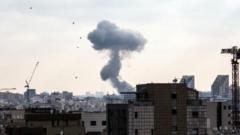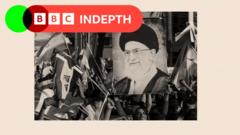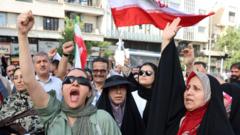This article explores the potential actions Iran might take in reaction to recent conflicts, including direct retaliation or negotiation options amidst internal and external pressures.
**Iran's Decision Dilemma: Retaliation Options Following US Airstrikes**

**Iran's Decision Dilemma: Retaliation Options Following US Airstrikes**
Iran faces critical choices in the aftermath of US airstrikes, weighing response strategies against regional risks.
As tensions escalate, following recent US airstrikes targeting Iranian nuclear sites, Iran finds itself at a crossroads regarding future actions. In the wake of these strikes, Iranian leadership is grappling with urgent discussions on whether to retaliate against US interests or engage in negotiations, as suggested by US President Donald Trump. The stakes of this decision are amplified by a backdrop of uncertainty and fear within Iran’s security apparatus about potential counter-strikes from Israel, emphasizing the precarious position the Islamic Republic occupies as it weighs its options.
Iran's military is reportedly divided among various strategic pathways, each fraught with risks to its regime survival. The first option is immediate and aggressive retaliation—an avenue that many within the Iranian leadership might favor due to perceived humiliations from both Israel and the US. However, executing an attack on US positions could drastically escalate conflict in the Middle East, endangering not just Iran but the entire region. Reports indicate Iran retains a significant stock of missiles, which could be deployed against US bases in the Gulf, though the repercussions may discourage such actions given regional alliances.
Alternatively, Iran could opt for a later retaliation. This strategy would involve waiting for a more opportune moment when US defenses may be less vigilant. However, this approach entails inherent risks, including the possibility of renewed US military actions at a time when normality begins to return to Iranian life. Therefore, timing will be critical for any potential strikes that Iranian strategists might consider.
Finally, the third option—abstaining from immediate retaliation—would require significant restraint from the Iranian leadership. This choice could include diplomatic negotiations to reinvigorate dialogue with the US, albeit under stringent terms that may require compromising on nuclear enrichment, a red line for Tehran. Yet, this path poses its challenges; inaction following a military strike could undermine the Islamic Republic’s credibility and embolden domestic dissent against the regime.
In the complex geopolitical landscape, Iran's leaders must navigate numerous factors, including the historical propensity for retaliation and the current pressure to maintain regime stability. The outcomes of these deliberations could reshape the balance of power in the region and redefine Iran's relationship with both the US and neighboring states, reaffirming that the path ahead is laden with uncertainty and potential repercussions.
Iran's military is reportedly divided among various strategic pathways, each fraught with risks to its regime survival. The first option is immediate and aggressive retaliation—an avenue that many within the Iranian leadership might favor due to perceived humiliations from both Israel and the US. However, executing an attack on US positions could drastically escalate conflict in the Middle East, endangering not just Iran but the entire region. Reports indicate Iran retains a significant stock of missiles, which could be deployed against US bases in the Gulf, though the repercussions may discourage such actions given regional alliances.
Alternatively, Iran could opt for a later retaliation. This strategy would involve waiting for a more opportune moment when US defenses may be less vigilant. However, this approach entails inherent risks, including the possibility of renewed US military actions at a time when normality begins to return to Iranian life. Therefore, timing will be critical for any potential strikes that Iranian strategists might consider.
Finally, the third option—abstaining from immediate retaliation—would require significant restraint from the Iranian leadership. This choice could include diplomatic negotiations to reinvigorate dialogue with the US, albeit under stringent terms that may require compromising on nuclear enrichment, a red line for Tehran. Yet, this path poses its challenges; inaction following a military strike could undermine the Islamic Republic’s credibility and embolden domestic dissent against the regime.
In the complex geopolitical landscape, Iran's leaders must navigate numerous factors, including the historical propensity for retaliation and the current pressure to maintain regime stability. The outcomes of these deliberations could reshape the balance of power in the region and redefine Iran's relationship with both the US and neighboring states, reaffirming that the path ahead is laden with uncertainty and potential repercussions.























